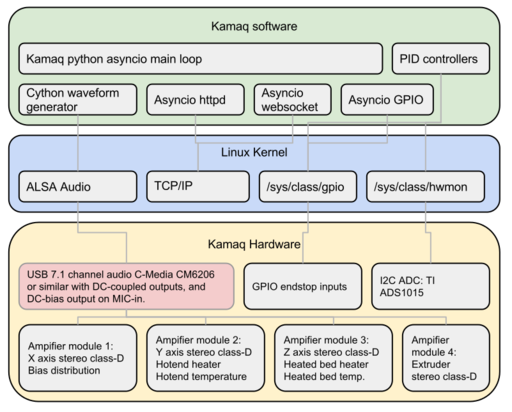Kamaq
This page is a development stub. Please enhance this page by adding information, cad files, nice big images, and well structured data!
Release status: working
[[image:|center|190px]]
| Description | Embedded-Linux based firmware and electronics
|
| License | GPL
|
| Author | |
| Contributors | |
| Based-on | |
| Categories | |
| CAD Models | |
| External Link |
Contents
Kamaq
Project Kamaq is a Linux-based RepRap firmware written in Python, with a web-interface in HTML5/JavaScript and websockets. It controls up to 4 stepper motors (axes) via standard USB audio device, end-switches and heaters via GPIO and hw-mon.
Status
Kamaq is fully functional to the point that it has been used successfully for many prints. It can control the printer hardware, execute gcode-file (stored locally, copied via scp or similar), and monitor progress graphically.
Features
- Web interface with real-time monitoring and feedback via websockets.
- Temperature plots for heaters
- Direct motor control panel
- Nifty print-speed scale slider to adjust printing speed in real-time
- Real-time plot of current layer movements in 2D
Hardware Requirements
For running Kamaq, you will need the following hardware:
- Embedded Linux system with reasonable processing power. Anything like a Raspberry-Pi or more powerful should work (Beagle-bone, etc...).
- USB Audio device (7.1 channel). You will need to short the output capacitors to get DC-response for better accuracy.
- 8-channel audio power amplifier with DC response and DC-offset biasing. Preferably class-D, even better if they have current-feedback.
- HWmon-compatible ADC for measuring temperatures.
- GPIO-connected power-MOSFET outputs for controlling heaters.
- GPIO inputs for endswitches.
Software requirements
Any embedded Linux system should do, if it has at least the following:
- Python 3.4 or newer
- Cython3 (at least for your build environment if cross-compiling) and GCC if compiling on the platform (i.e. Ubuntu-ARM or similar).
- GPIO drivers with sysfs interface for your chipset (should be standard on Mainline-Linux kernels).
- HW-mon driver for your ADC (I use a ADS1015 from TI... it has Mainline-Linux drivers).
System overview
The following diagram shows an overview of the whole system:
Electronics
The electronics consists basically of an Embedded-Linux board like a Raspberry-pi, Beagle-Bone or similar with some GPIOs, USB-host, Ethernet and an I2C bus, a common USB 7.1 (8-) channel audio card and 4 nearly identical amplifier PCB's.
USB Audio device
USB Audio devices are powered by positive supply only, and thus need a positive DC-offset on each output in order to be able to produce a symmetric audio waveform. Normally this DC-offset is eliminated from the output by DC-blocking capacitors. For motor control however, we need DC-coupled outputs. For this reason we need to short out these DC-blocking capacitors. The datasheet of the C-Media CM6206 shows a typical application schematic in chapter 10.
We need a reference of this DC-offset level, in order to eliminate this offset in the output stage, and generate a nice symmetrical voltage on the motor coils. Fortunately, most of these USB audio devices use the same reference voltage as microphone bias also. So we can use the microphone bias output as a bias-source for the input stage of the amplifier modules.
Amplifier modules
Each amplifier module consists of some OP-amps for DC-biasing, a stereo Class-D audio power-amplifier, an optional low-side switch (MOSFET) for controlling a heater element, and an extra OP-amp for thermistor signal amplification or biasing distribution. At least two of the modules are equipped with a MOSFET switch output: one for the heated bed and the other for the hotend. There is a quad-OPamp on each amplifier board. Of the four OPamps, three are used for biasing the power-amplifier and one for amplifying the thermistor signal. The latter can also be used (with unity-gain) as buffer for distributing the bias voltage from the USB audio device.
